[English] 日本語
 Yorodumi
Yorodumi- PDB-5mo9: Structure of human TrkB receptor ligand binding domain in complex... -
+ Open data
Open data
- Basic information
Basic information
| Entry | Database: PDB / ID: 5mo9 | ||||||
|---|---|---|---|---|---|---|---|
| Title | Structure of human TrkB receptor ligand binding domain in complex with the Fab frgment of antibody AB20 | ||||||
 Components Components |
| ||||||
 Keywords Keywords | IMMUNE SYSTEM / Trk receptor / antibody / antigen / complex | ||||||
| Function / homology |  Function and homology information Function and homology informationbrain-derived neurotrophic factor binding / brain-derived neurotrophic factor receptor activity / BDNF activates NTRK2 (TRKB) signaling / NTF4 activates NTRK2 (TRKB) signaling / NTF3 activates NTRK2 (TRKB) signaling / brain-derived neurotrophic factor receptor signaling pathway / Activated NTRK2 signals through PLCG1 / retinal rod cell development / peripheral nervous system neuron development / trans-synaptic signaling by BDNF, modulating synaptic transmission ...brain-derived neurotrophic factor binding / brain-derived neurotrophic factor receptor activity / BDNF activates NTRK2 (TRKB) signaling / NTF4 activates NTRK2 (TRKB) signaling / NTF3 activates NTRK2 (TRKB) signaling / brain-derived neurotrophic factor receptor signaling pathway / Activated NTRK2 signals through PLCG1 / retinal rod cell development / peripheral nervous system neuron development / trans-synaptic signaling by BDNF, modulating synaptic transmission / mechanoreceptor differentiation / neurotrophin binding / Activated NTRK2 signals through CDK5 / NTRK2 activates RAC1 / Activated NTRK2 signals through FYN / NGF-independant TRKA activation / Activated NTRK2 signals through PI3K / myelination in peripheral nervous system / feeding behavior / positive regulation of axonogenesis / neuronal action potential propagation / glutamate secretion / positive regulation of synapse assembly / regulation of GTPase activity / central nervous system neuron development / negative regulation of amyloid-beta formation / oligodendrocyte differentiation / negative regulation of anoikis / Activated NTRK2 signals through RAS / Activated NTRK2 signals through FRS2 and FRS3 / vasculogenesis / cellular response to brain-derived neurotrophic factor stimulus / axon terminus / cell surface receptor protein tyrosine kinase signaling pathway / learning / cellular response to amino acid stimulus / positive regulation of neuron projection development / receptor protein-tyrosine kinase / circadian rhythm / cerebral cortex development / neuron migration / long-term synaptic potentiation / neuron differentiation / terminal bouton / Constitutive Signaling by Aberrant PI3K in Cancer / PIP3 activates AKT signaling / protein autophosphorylation / PI5P, PP2A and IER3 Regulate PI3K/AKT Signaling / protease binding / early endosome membrane / dendritic spine / negative regulation of neuron apoptotic process / early endosome / positive regulation of phosphatidylinositol 3-kinase/protein kinase B signal transduction / receptor complex / positive regulation of MAPK cascade / postsynaptic density / axon / positive regulation of cell population proliferation / dendrite / positive regulation of gene expression / perinuclear region of cytoplasm / protein homodimerization activity / ATP binding / plasma membrane / cytosol Similarity search - Function | ||||||
| Biological species |   Homo sapiens (human) Homo sapiens (human) | ||||||
| Method |  X-RAY DIFFRACTION / X-RAY DIFFRACTION /  SYNCHROTRON / SYNCHROTRON /  MOLECULAR REPLACEMENT / Resolution: 2.594 Å MOLECULAR REPLACEMENT / Resolution: 2.594 Å | ||||||
 Authors Authors | Hoerer, S. | ||||||
 Citation Citation |  Journal: J. Pharmacol. Exp. Ther. / Year: 2017 Journal: J. Pharmacol. Exp. Ther. / Year: 2017Title: Pharmaceutical Characterization of Tropomyosin Receptor Kinase B-Agonistic Antibodies on Human Induced Pluripotent Stem (hiPS) Cell-Derived Neurons. Authors: Traub, S. / Stahl, H. / Rosenbrock, H. / Simon, E. / Florin, L. / Hospach, L. / Horer, S. / Heilker, R. | ||||||
| History |
|
- Structure visualization
Structure visualization
| Structure viewer | Molecule:  Molmil Molmil Jmol/JSmol Jmol/JSmol |
|---|
- Downloads & links
Downloads & links
- Download
Download
| PDBx/mmCIF format |  5mo9.cif.gz 5mo9.cif.gz | 146.3 KB | Display |  PDBx/mmCIF format PDBx/mmCIF format |
|---|---|---|---|---|
| PDB format |  pdb5mo9.ent.gz pdb5mo9.ent.gz | 113.2 KB | Display |  PDB format PDB format |
| PDBx/mmJSON format |  5mo9.json.gz 5mo9.json.gz | Tree view |  PDBx/mmJSON format PDBx/mmJSON format | |
| Others |  Other downloads Other downloads |
-Validation report
| Arichive directory |  https://data.pdbj.org/pub/pdb/validation_reports/mo/5mo9 https://data.pdbj.org/pub/pdb/validation_reports/mo/5mo9 ftp://data.pdbj.org/pub/pdb/validation_reports/mo/5mo9 ftp://data.pdbj.org/pub/pdb/validation_reports/mo/5mo9 | HTTPS FTP |
|---|
-Related structure data
| Related structure data |  1hcfS S: Starting model for refinement |
|---|---|
| Similar structure data |
- Links
Links
- Assembly
Assembly
| Deposited unit | 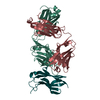
| ||||||||
|---|---|---|---|---|---|---|---|---|---|
| 1 |
| ||||||||
| Unit cell |
|
- Components
Components
| #1: Antibody | Mass: 23675.535 Da / Num. of mol.: 1 Source method: isolated from a genetically manipulated source Source: (gene. exp.)   |
|---|---|
| #2: Antibody | Mass: 23931.635 Da / Num. of mol.: 1 Source method: isolated from a genetically manipulated source Source: (gene. exp.)   |
| #3: Protein | Mass: 16909.578 Da / Num. of mol.: 1 Source method: isolated from a genetically manipulated source Details: Fragment: Ligand binding domain / Source: (gene. exp.)  Homo sapiens (human) / Gene: NTRK2, TRKB / Plasmid: pET15b / Production host: Homo sapiens (human) / Gene: NTRK2, TRKB / Plasmid: pET15b / Production host:  References: UniProt: Q16620, receptor protein-tyrosine kinase |
| #4: Water | ChemComp-HOH / |
| Has protein modification | Y |
-Experimental details
-Experiment
| Experiment | Method:  X-RAY DIFFRACTION / Number of used crystals: 1 X-RAY DIFFRACTION / Number of used crystals: 1 |
|---|
- Sample preparation
Sample preparation
| Crystal | Density Matthews: 2.27 Å3/Da / Density % sol: 44.47 % / Description: rod-shaped |
|---|---|
| Crystal grow | Temperature: 293 K / Method: vapor diffusion, sitting drop / pH: 8.5 / Details: 6% w/v PEG 3350, 25 mM Tris pH 8.5 |
-Data collection
| Diffraction | Mean temperature: 100 K |
|---|---|
| Diffraction source | Source:  SYNCHROTRON / Site: SYNCHROTRON / Site:  SLS SLS  / Beamline: X06SA / Wavelength: 1.0005 Å / Beamline: X06SA / Wavelength: 1.0005 Å |
| Detector | Type: DECTRIS PILATUS 6M-F / Detector: PIXEL / Date: Sep 18, 2014 |
| Radiation | Monochromator: Si(111) monochromator / Protocol: SINGLE WAVELENGTH / Monochromatic (M) / Laue (L): M / Scattering type: x-ray |
| Radiation wavelength | Wavelength: 1.0005 Å / Relative weight: 1 |
| Reflection | Resolution: 2.594→37.402 Å / Num. obs: 18392 / % possible obs: 100 % / Redundancy: 6.4 % / Biso Wilson estimate: 34.87 Å2 / CC1/2: 0.995 / Rmerge(I) obs: 0.158 / Net I/σ(I): 11 |
| Reflection shell | Resolution: 2.594→2.639 Å / Redundancy: 6.6 % / Rmerge(I) obs: 0.963 / Mean I/σ(I) obs: 2.2 / CC1/2: 0.744 / % possible all: 99.9 |
- Processing
Processing
| Software |
| ||||||||||||||||||||||||||||||||||||||||||||||||||||||||||||||||||||||||||||||||||||||||||||||||||||||||||||||||||||||||||||||||||||||||||||||||||||||
|---|---|---|---|---|---|---|---|---|---|---|---|---|---|---|---|---|---|---|---|---|---|---|---|---|---|---|---|---|---|---|---|---|---|---|---|---|---|---|---|---|---|---|---|---|---|---|---|---|---|---|---|---|---|---|---|---|---|---|---|---|---|---|---|---|---|---|---|---|---|---|---|---|---|---|---|---|---|---|---|---|---|---|---|---|---|---|---|---|---|---|---|---|---|---|---|---|---|---|---|---|---|---|---|---|---|---|---|---|---|---|---|---|---|---|---|---|---|---|---|---|---|---|---|---|---|---|---|---|---|---|---|---|---|---|---|---|---|---|---|---|---|---|---|---|---|---|---|---|---|---|---|
| Refinement | Method to determine structure:  MOLECULAR REPLACEMENT MOLECULAR REPLACEMENTStarting model: 1hcf Resolution: 2.594→37 Å / Cor.coef. Fo:Fc: 0.931 / Cor.coef. Fo:Fc free: 0.902 / SU R Cruickshank DPI: 0.466 / Cross valid method: THROUGHOUT / σ(F): 0 / SU R Blow DPI: 0.513 / SU Rfree Blow DPI: 0.254 / SU Rfree Cruickshank DPI: 0.253
| ||||||||||||||||||||||||||||||||||||||||||||||||||||||||||||||||||||||||||||||||||||||||||||||||||||||||||||||||||||||||||||||||||||||||||||||||||||||
| Displacement parameters | Biso mean: 47.98 Å2
| ||||||||||||||||||||||||||||||||||||||||||||||||||||||||||||||||||||||||||||||||||||||||||||||||||||||||||||||||||||||||||||||||||||||||||||||||||||||
| Refine analyze | Luzzati coordinate error obs: 0.31 Å | ||||||||||||||||||||||||||||||||||||||||||||||||||||||||||||||||||||||||||||||||||||||||||||||||||||||||||||||||||||||||||||||||||||||||||||||||||||||
| Refinement step | Cycle: 1 / Resolution: 2.594→37 Å
| ||||||||||||||||||||||||||||||||||||||||||||||||||||||||||||||||||||||||||||||||||||||||||||||||||||||||||||||||||||||||||||||||||||||||||||||||||||||
| Refine LS restraints |
| ||||||||||||||||||||||||||||||||||||||||||||||||||||||||||||||||||||||||||||||||||||||||||||||||||||||||||||||||||||||||||||||||||||||||||||||||||||||
| LS refinement shell | Resolution: 2.11→2.21 Å / Rfactor Rfree error: 0 / Total num. of bins used: 11
| ||||||||||||||||||||||||||||||||||||||||||||||||||||||||||||||||||||||||||||||||||||||||||||||||||||||||||||||||||||||||||||||||||||||||||||||||||||||
| Refinement TLS params. | Method: refined / Refine-ID: X-RAY DIFFRACTION
| ||||||||||||||||||||||||||||||||||||||||||||||||||||||||||||||||||||||||||||||||||||||||||||||||||||||||||||||||||||||||||||||||||||||||||||||||||||||
| Refinement TLS group |
|
 Movie
Movie Controller
Controller


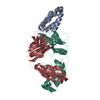
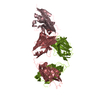

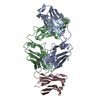
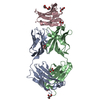
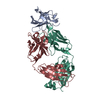

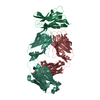
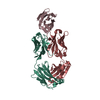

 PDBj
PDBj














